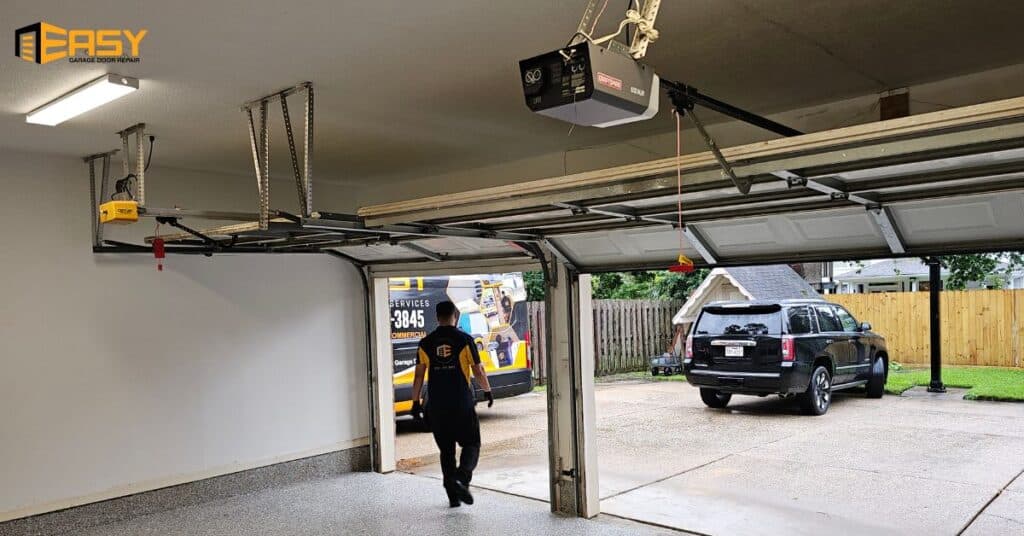By installing a garage door opener yourself instead of hiring someone to do it, you can save approximately $200 to $400. This effort is well within the reach of most people because installing a garage door opener is not rocket science. Moreover, the tools required are few, and the special skills required are almost nonexistent. It is, nevertheless, notable to see that this process demands a particular level of DIY ability, the right tools, and a presumed commitment of 4 to 6 hours over one of your weekends. Another major consideration is safety. Handling heavy equipment and electrical components makes this a process that has many serious safety issues attached to it. You can easily accomplish this task and keep a secure environment if you follow the proper rules and regulations.
In this guide, we’ll walk you through every step of the installation process, from unpacking the box to programming your remotes. You’ll learn how to install a garage door opener, which tools you need, how to handle the tricky parts, and most importantly, when it’s better to call pros. We’ll also cover common mistakes that can turn a simple installation into an expensive repair job

Follow Safety and Prerequisites
Installing a garage door opener requires a certain level of expertise and comfort with electrical systems and heavy machinery. If you do not feel confident in your ability to handle these tasks, it is advisable to hire a professional. Prioritizing safety is essential, and opting for professional installation can ensure that the job is completed correctly while minimizing risks.
Essential Safety Warnings
The biggest danger in garage door work isn’t the opener. It’s those torsion springs above your door. These springs are under extreme tension and can cause serious injury or death if handled incorrectly. If your springs need any adjustment during installation, stop immediately and call a professional. This isn’t negotiable.
When it comes to electrical work, always turn off the power at your breaker box before starting. Even if you think you know which circuit controls the garage, flip the main breaker to be sure. Garage door openers typically require a standard 120V outlet, but if you need to install new wiring, that’s electrician territory.
Pre-Installation Requirements
Before you even open that opener box, make sure your garage door is in good working order. Disconnect the door from any existing opener and test it manually. The door should stay in place when you lift it halfway – if it falls or shoots up, your springs need adjustment by a professional.
Verify the height of your garage ceiling. Most garage door openers require 2 inches minimum clearance above the door. If you have a low ceiling or an unusual door configuration, you might need a special low-profile opener or individual professional help to get your door working.
Tools Required
What you will require in your toolbox is as follows: a drill with bits; socket wrenches; screwdrivers; a level; a tape measure; a stepladder (at least 6 feet); wire strippers; and safety glasses. For some installations, a hacksaw is also needed to cut the rail to size.
Install a Garage Door Opener: Checklist from Experts
Step 1: Assemble the Rail System
- Start by laying out all the parts on the garage floor.
- Most opener kits include several rail sections that connect to form a long track.
- Arrange the rail sections in order and connect them according to your manual:
- Usually involves sliding them together and securing with bolts.
Before mounting anything, install the trolley (the part that moves along the rail and connects to your door) onto the rail: - Slide it onto the rail from the motor end.
- Ensure it moves smoothly without sticking.
- If it gets stuck or jumps, your rail sections may not be aligned correctly.
- Usually involves sliding them together and securing with bolts.
Common mistakes to avoid:
- Forcing pieces together that don’t fit.
- If you have to use excessive force, something is wrong.
- Double-check that you have the right pieces in the correct order.
- Some rails have a slight curve that must face the right direction; installing them backward can cause issues later.
Step 2: Install the Motor Unit
Use the mounting brackets provided and ensure everything is level:
- A tilted motor can cause premature wear and noisy operation.
Most motors attach to the ceiling with lag screws into the joists:
- If your joists don’t line up with the motor, install a support board across multiple joists.
- Never attach the motor to drywall alone; it needs solid wood backing to handle vibration and weight.
Once the motor is secure, attach the rail:
- One end connects to the motor, while the other attaches to a header bracket above your garage door.
- Getting this angle right is crucial:
- Too steep, and the door won’t open fully.
- Too shallow, and it might not close properly.
The electrical connections are usually straightforward:
- Simply plug the unit into your outlet.
- Pay attention to any safety sensors or wall controls that need wiring.
- If your kit requires hardwiring or modifications to existing wiring, consider calling an electrician.
Step 3: Attach Rail to Door
- The header bracket goes on the wall above your garage door:
- Ensure it is centered and level.
- This bracket takes a lot of stress, so use the heavy-duty lag screws provided.
- Make sure you’re drilling into solid wood framing, not just drywall.
- Next, install the door bracket, which attaches to the top section of your garage door:
- Position it according to your manual’s specifications, usually centered and a specific distance down from the top.
- This bracket connects to the trolley arm, creating the mechanical link between the opener and your door.
- When connecting the arm between the trolley and door bracket, pay attention to the angle:
- With the door closed, the arm should be relatively straight or slightly angled.
- Too much angle reduces lifting power and puts extra stress on the system.
- Test the manual release at this point:
- Pull the emergency cord; the door should disconnect from the opener and move freely by hand.
- This feature is crucial during power outages or if the opener fails. Ensure everyone in your household knows how to use it.
Step 4: Install Safety Features
- Modern garage door openers come with photo-eye sensors that prevent the door from closing if something is in the way:
- Mount these sensors on either side of the door opening, about 6 inches off the ground.
- Ensure they are perfectly aligned; even slight misalignment can prevent the door from closing.
- Securely mount the sensors to avoid vibration that could throw them out of alignment:
- Run the wires carefully along the wall and ceiling, securing them with insulated staples.
- Keep wires tidy to prevent them from getting caught in the door mechanism or damaged.
- Mount the wall control panel at least 5 feet off the ground:
- This keeps it out of reach of small children and away from the door’s moving parts.
- Most modern units have built-in safety features, including motion sensors and automatic lighting.
- Perform the safety reversal test:
- Place a 2×4 board flat on the ground under the door and close it with the opener.
- The door should immediately reverse when it touches the board.
- If it doesn’t, adjust the force settings as outlined in your manual; this is critical for preventing injuries.
Step 5: Programming and Testing
- Programming your remotes is usually the easiest part:
- Most openers have a “learn” button on the motor unit.
- Press the “learn” button, then press your remote button within 30 seconds.
- The motor light will flash to confirm programming. Repeat for each remote.
- Setting the travel limits tells the opener how far to move the door:
- Start with the door closed and adjust the down limit until the door seals properly against the ground without excessive pressure.
- Open the door and adjust the up limit so it opens completely without the trolley hitting the stop bolt.
- Force settings control how much power the opener uses:
- Too little power may prevent the door from opening in cold weather or if the tracks are dirty.
- Too much power can create a safety hazard.
- Start with the manufacturer’s recommended settings and fine-tune based on your door’s weight and balance.
- Test everything multiple times:
- Open and close the door using the remote, wall button, and any smart home connections.
- Listen for unusual noises, watch for smooth operation, and ensure the door stops properly at both limits.
Step 6: Final Safety Checks
- Run through a complete safety checklist before calling the job done.
- Test the photo-eyes by walking through the beam while the door is closing.
- Check the auto-reverse with that 2×4 board again.
- Make sure the manual release works smoothly and re-engages properly.
- Verify that all bolts and screws are tight; vibration can loosen connections over time.
- Check that wires are secured and away from moving parts.
- Make sure the antenna wire on the motor unit is hanging down for best remote range.
- Look for any binding or unusual resistance as the door operates.
A properly installed opener should run smoothly and relatively quietly. Squeaking, grinding, or jerky motion indicates something needs adjustment.
When to Choose Professional Installation
Some situations just call for professional expertise. If you have a high-lift door, low headroom, or any unusual configuration, the installation gets exponentially more complex. These setups often require special brackets, modified rails, or creative mounting solutions that go beyond basic DIY skills.
Any time you require electrical work beyond plugging in the opener, bring in a licensed electrician. This includes running new circuits, installing outlets, or dealing with old wiring. The cost of doing it right is nothing compared to the risk of electrical fires or code violations that could affect your insurance.
If your garage door requires repairs before opener installation, especially spring work, always trust professionals. Trying to save money by tackling an opener replacement yourself is genuinely life-threatening. Professional installers have the right tools and experience to handle these dangerous components safely.

Professional Garage Door Opener Installation Services
At Easy Garage Door Repair, we offer complete garage door opener installation throughout the Houston area. Our licensed technicians handle everything from basic installations to complex custom configurations. We work with all major brands and can help you choose the right opener for your specific door and needs.
Our installation service includes replacing old equipment, professional mounting and wiring, complete safety setup and testing, and programming of all remotes and accessories. We also provide a comprehensive walkthrough, so you understand all your opener’s features. Call us at (832) 570-3845 for expert garage door opener installation with full warranty coverage. We offer same-day service across Houston, Sugar Land, Katy, and surrounding areas.
Garage Door Opener Installation FAQ
How long does it take to install a garage door opener?
For an experienced DIYers with all the right tools, expect 4–6 hours for a standard installation. Professional installation typically takes 2-3 hours since we come prepared with everything needed.
What tools do I need for installation?
Essential tools include a drill with bits, a socket wrench set, screwdrivers, a level, a tape measure, a stepladder, wire strippers, and safety glasses. You might also need a hacksaw, stud finder, and angle grinder, depending on your specific installation. Don’t have everything? Factor tool purchases or rentals into your DIY cost comparison.
Can I install an opener on any garage door?
Most residential garage doors can accommodate an opener, but some require special considerations. One-piece tilt-up doors need a different type of opener than sectional doors. Extremely heavy wood doors might exceed standard opener capacities. Damaged or poorly balanced doors should be repaired before opener installation.
Do I need an electrical permit for installation?
If you’re just plugging into an existing outlet, usually no permit is needed. But if you’re running new wiring or installing an outlet, most areas require a permit and inspection. Check with your local building department in Houston and surrounding cities; each has its own requirements.
What if my garage door doesn’t work properly after installation?
First, recheck all your settings – travel limits and force adjustments solve most problems. Verify the door was balanced before installation. Check for binding in the tracks or damaged rollers. If basic troubleshooting doesn’t help, you might have a compatibility issue or a defective opener that requires professional diagnosis.
How do I know if my opener is installed correctly?
A properly installed opener operates smoothly and quietly, stops at the correct positions, reverses when it hits an obstruction, and responds consistently to all controls. The door should stay closed without gaps and open fully without the trolley hitting stops. Any jerky motion, unusual noises, or inconsistent operation indicates problems.
Can I upgrade my old opener to a smart opener?
Many newer openers include smart features like smartphone control and integration with home automation systems. If your old opener is relatively recent, you might be able to add a smart controller. But older units often lack the necessary technology, making complete replacement the better option for smart features.possible.








